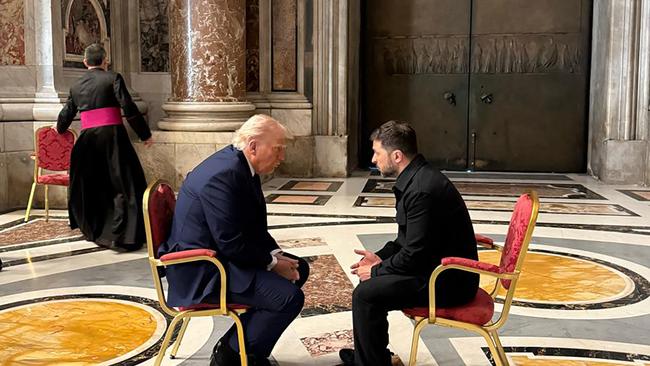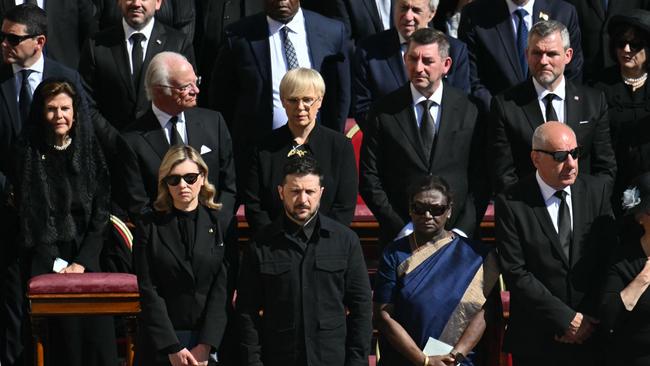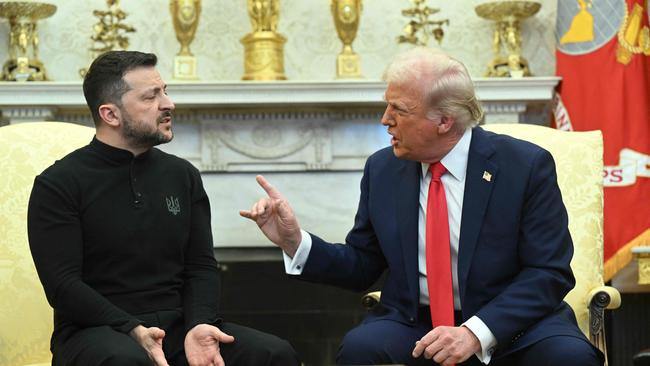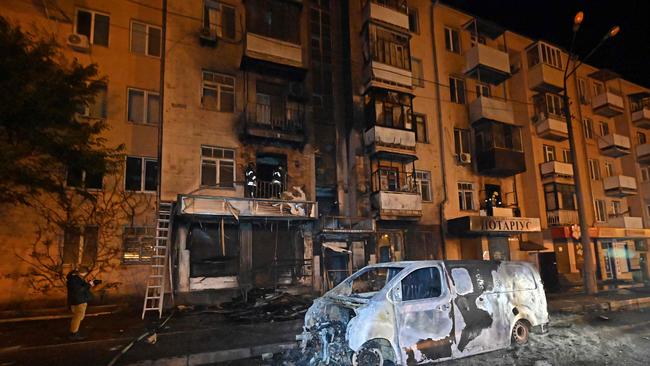Face-to-face at the Vatican: How Trump and Zelensky made up
Zelensky’s showmanship helped rally the world against Russia’s invasion, but it has grated on Trump.

As thousands of mourners gathered outside St. Peter’s Basilica for the funeral of Pope Francis, two presidents sat huddled inside amid the near-silence, beneath an 18th century painting of the baptism of Jesus.
Ukrainian President Volodymyr Zelensky was seeking a measure of salvation for his country—and himself—after a disastrous February meeting in the Oval Office led President Trump to temporarily halt weapons deliveries.
The 15-minute meeting last Saturday was the result of both planning and spontaneity, according to officials familiar with the matter. European officials had been working to heal the rift, which threatened to strip Ukraine of its main strategic ally at a critical juncture in its war with Russia.
French President Emmanuel Macron, a champion of Zelensky who has sought to smooth the Ukrainian leader’s tensions with Trump, began talking with the US president as leaders gathered in the Basilica ahead of the funeral. “We need to be much tougher with the Russians,” Macron said to Trump, he told Paris Match magazine.
Zelensky then approached, and he and Trump agreed to talk. One chair set for an interpreter was removed because Zelensky preferred to speak with Trump one-on-one, Macron said.
“It was a beautiful meeting, I tell you, it was the nicest office I’ve ever seen,” Trump told reporters Sunday. “It was a beautiful scene.”
For his part, Zelensky said it was their best conversation to date. “Maybe it was the shortest, but it was the most substantive,” he told reporters in his office. “With all respect to our teams, this tete-a-tete format, in my opinion, worked.”
It is too early to tell if the meeting marked an inflection point, though it yielded some immediate results. Afterward, Trump offered unusually sharp criticism of Russian

President Vladimir Putin. Zelensky said they had spoken about a contentious economic deal, which Ukraine and the Trump administration signed Wednesday, removing an irritant in relations.
But Trump hasn’t imposed any further sanctions on Russia, as he said he could after the meeting, and he has continued criticism of Zelensky.
Diplomacy has for centuries been guided by theater as well as talks, from seating plans at dinners to the exchange of symbolic gifts. That is especially true for Trump and Zelensky, two renowned showmen with a flair for performance—which has sometimes proved a thorn in relations.
European leaders have relied on displays of pageantry in attempts to win over Trump. Macron invited him to a military parade on Bastille Day in 2017, and British Prime Minister Keir Starmer presented Trump in February with an invitation from King Charles III to a historic second state visit to Britain. Trump attended a state banquet with Queen Elizabeth II in 2019.
Mike Waltz, who was removed as national security adviser this week by Trump, noted the grandeur of the surroundings in Rome in an interview with Fox News. “Just standing there in that moment—in that place surrounded by the marble…and having those two leaders face-to-face doing tough diplomacy, I thought: ‘It will be one of those iconic historic moments,’” he said, adding that Trump had “loved the gold.”
Zelensky’s political career has relied on such cinematic moments. The former comic actor won the presidency in a landslide in 2019 with an outsider campaign, including a stadium debate with the incumbent to whom he said, “I am the result of your mistakes.”
The 47-year-old leader’s popularity was sliding before Russia’s invasion on Feb. 24, 2022, when he displayed bravery and communication skills that won him global praise. The day after, he publicized his defiant stand in Kyiv with a video of himself and top advisers at the presidential office in the heart of the capital, with Russian tanks a few miles away.
“The president is here,” he said. “We are all here. Our troops are here. We are defending our independence, our state, and that will continue.”
The display of resolve encouraged Western governments to send military aid to Ukraine, winning praise even from Trump, who called Zelensky brave and condemned the war.

At times, however, Zelensky’s blunt talk has irked allies. After he pushed the issue of Ukrainian membership in the North Atlantic Treaty Organization in a White House meeting with President Joe Biden in 2022, one Zelensky adviser recalled Biden saying firmly: “No NATO.”
The direct style has proved a particular irritant to Trump, who has his own unfiltered manner.
When Zelensky said in February he was worried that Trump was adopting Kremlin talking points, the US leader fired back that he was a “dictator without elections.”
At the Oval Office in late February, Zelensky was on a rescue mission to firm up support from Trump, who took office criticizing aid to Ukraine and was demanding Kyiv sign an economic deal to recoup billions.
Some US officials had counseled Zelensky to have a minister sign the deal, but Zelensky pushed for a personal meeting with Trump.
The Ukrainian leader came bearing the world championship belt of Ukrainian boxer Oleksandr Usyk, taking a leaf from the diplomatic playbook of Israeli Prime Minister Benjamin Netanyahu, who gifted Trump a gold pager to commemorate the operation to blow up Hezbollah operatives in Lebanon.
But he never got to present the belt. Trump’s team evicted the Ukrainian delegation from the White House after the meeting descended into acrimony when Vice President JD Vance accused Zelensky of being ungrateful for American help. Zelensky bristled as he attempted to defend his position against Trump and Vance.
While Zelensky’s performance went down badly in Washington, especially among Trump’s Republican allies, Ukrainians rallied behind him. Trust in him surged to 67 per cent after the meeting, up from a wartime low of 52 per cent in December, according to polls by the Kyiv International Institute of Sociology.
“If he had said anything else, he would have lost support at home,” said Olga Onuch, professor of comparative and Ukrainian politics at the University of Manchester in Britain and author of the book, “The Zelensky Effect.” “Even people who despise him in Ukraine saw that he was keeping to the Ukrainian views and red lines.”
Zelensky has since softened his approach to Trump. In a letter, he expressed regret for the dust-up, later agreeing to a US proposal for a 30-day cease-fire while Russia demurred. Ukrainian negotiators also signed up for a truce in the Black Sea that was of little benefit to Kyiv, and have moved ahead with a minerals deal despite the absence of concrete security guarantees from the US.
Still, critics say Zelensky hasn’t done enough to mollify Trump. While the Kremlin commissioned a portrait of Trump and has avoided reacting to his statements, Zelensky has at times dug in his heels.
“Zelensky comes from an industrial town,” said Ihor Novikov, who was an adviser to Zelensky during Trump’s first term. “He’s got that street mentality so the harder you push him the more he recoils and pushes back.”
Zelensky and Trump came together last weekend as foreign leaders gathered ahead of the funeral at St. Peter’s Basilica, the ornate church completed in the 17th century and held by Catholics to be the burial site of St. Peter, traditionally considered the first pope. In life, Pope Francis’ appeals for peace frustrated many Ukrainians who saw him as too soft on Moscow. During a meeting at the Vatican last year, Francis presented Zelensky with a bronze sculpture of a flower bearing the inscription “peace is a fragile flower.” Zelensky gifted him an oil painting depicting the horror of Russian war crimes in the Kyiv suburb of Bucha.
After exchanging words with Trump and shaking hands with Zelensky, Macron was seen stepping back in a video filmed by White House deputy chief of staff Dan Scavino, as a priest arranged three chairs on the marble floor by the baptistery chapel. Secret Service agents hovered.
Photographs of the meeting shared by Zelensky’s office show the two men locked in conversation while hunched over and leaning closer to each other.
“The best thing about that meeting is that it was just the two of them,” said Zelensky’s former adviser, Novikov. “It’s just a question of egos being overinflated by the people that are close to them. If you have (US special envoy Steve) Witkoff there, you have JD Vance—it gets distorted.”
Outside later, applause was heard as Zelensky, wearing black fatigues, walked toward his seat for the funeral and greeted suited dignitaries, in a sign of his enduring star power.

Both sides have been largely tight-lipped about what was discussed, describing the conversation as “constructive.” Hours later, Trump delivered one his sharpest rebukes yet to Putin, questioning whether he really sought peace and waving the threat of banking or secondary sanctions.
In an interview with ABC, Trump described the meeting as “a moment of solace in a sense, because…a lot of his people are dying and I feel very badly about it.”
Zelensky again requested more weapons during the meeting, Trump told reporters.
“It was a meaningful meeting, and President Trump and I used every minute to the fullest,” Zelensky said.
The meeting was remarkably intimate in diplomatic terms and improved the atmosphere between the two leaders, but it didn’t fundamentally alter the dynamics of the relationship, said defense analyst Michael Clarke.
“Trump’s ambition is a rapprochement with Russia on a global scale and so Zelensky just represents an irritation,” Clarke said. “No amount of talking will change that.”
Days after the meeting, Trump was asked in an interview if there was anything Putin could do that would cause him to say he was on Zelensky’s side. “On Ukraine’s side, yes. But not necessarily on Zelensky’s side,” he told The Atlantic. “I’ve had a hard time with Zelensky.”
Wall Street Journal





To join the conversation, please log in. Don't have an account? Register
Join the conversation, you are commenting as Logout